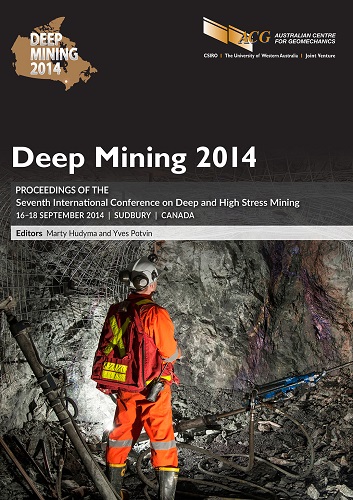Simulation of mining-induced seismicity using the Salamon–Linkov method

|
Authors: Malovichko, D; Basson, G |
DOI https://doi.org/10.36487/ACG_rep/1410_47_Malovichko
Cite As:
Malovichko, D & Basson, G 2014, 'Simulation of mining-induced seismicity using the Salamon–Linkov method', in M Hudyma & Y Potvin (eds), Deep Mining 2014: Proceedings of the Seventh International Conference on Deep and High Stress Mining, Australian Centre for Geomechanics, Perth, pp. 667-680, https://doi.org/10.36487/ACG_rep/1410_47_Malovichko
Abstract:
An approach to model seismicity induced by mining was proposed by MDG Salamon and developed further by AM Linkov. We suggest a variation of the Salamon–Linkov method that does not require a priori assumptions about sizes, orientations and locations of flaws, reducing the amount of input data. The algorithm places a 3D grid over the model domain and searches the entire grid space for possible planes of failure by identifying lobes of positive Coulomb Failure Stress (CFS). The largest CFS lobes are then utilised as flaws. Another change from the original formulation is that the flaws are discretised into smaller sub flaws. This accounts for the complexity of the shapes of the flaws and provides more accurate modelling of their effect on the stress field. Some elements of the original framework of Salamon and Linkov, e.g. tensile failure and creep effects are not included into our implementation. This is done intentionally to keep the method simple at the current stage. The implemented method requires limited input data: models of mining steps, information about virgin stress, rock mass elastic properties and strength. The strength may be anisotropic and inhomogeneous, where specific Mohr–Coulomb failure criteria can be assigned to particular orientations (describing joint sets) and 3D surfaces (describing faults or dykes). The output of the method represents two catalogues - one for seismic and another for aseismic events. The catalogues contain origin times (mining steps), coordinates, seismic potencies and source mechanisms of events. The method was applied to real case studies at two mines. The Boundary Element Method (BEM) models of the mines were of the order of 200,000 Fictitious Force (FF) elements. The first model included seven mining steps and the second model consisted of 33 steps. The computations took seven and 50 hours respectively on a multi-core machine. In the first case the resulting catalogue includes more than 900 seismic events, whereas in the second case the catalogues contained approximately 3,400 seismic and 100 aseismic events. The modelled seismicity may be used as a reference for the interpretation of the observed seismicity. Analysing the discrepancies between the modelled and observed seismicity can also help to assess the validity of input parameters – characteristics of in situ stress and failure criteria. Another possible application of the suggested method is the testing of future mining scenarios. Although the prediction of seismic response for individual scenarios may be not accurate, the difference between the modelled seismicity of the scenarios may help to choose the optimal one in regards to seismic or ground motion hazard.
References:
Linkov, AM 2005, ‘Numerical modeling of seismic and aseismic events in geomechanics’, Journal of Mining Science, vol. 41, no. 1, pp. 14-26.
Linkov, AM 2013, ‘Keynote lecture: Numerical modelling of seismicity: Theory and applications’, in A Malovichko & D Malovichko (eds), Proceedings of the 8th International Symposium on Rockbursts and Seismicity in Mines: RaSiM8, Geophysical Survey of Russian Academy of Sciences, Obninsk, Mining Institute of Ural Branch of Russian Academy of Sciences, Perm,
pp. 197-218.
McKinnon, SD 2006, ‘Triggering of seismicity remote from active mining excavations’, Rock Mechanics and Rock Engineering, vol. 39, no. 3, pp. 255-279.
Salamon, MDG 1993, ‘Keynote address: Some applications of geomechanical modelling in rockburst and related research’, in P Young (ed.), Proceedings of the 3rd International Symposium on Rockbursts and Seismicity in Mines, A.A. Balkema, Rotterdam, pp. 297-309.
Sellers, EJ & Napier, JAL 2001, ‘A point kernel representation of large-scale seismic activity in mining’, in G van Aswegen, RJ Durrheim & WD Ortlepp (eds), Proceedings of the 5th International Symposium on Rockbursts and Seismicity in Mines, South African Institute of Mining and Metallurgy, Johannesburg, pp. 405-411.
Spottiswoode, S 2001, ‘Keynote address: Synthetic seismicity mimics observed seismicity in deep tabular mines’, in G van Aswegen, RJ Durrheim & WD Ortlepp (eds), Proceedings of the 5th International Symposium on Rockbursts and Seismicity in Mines, South African Institute of Mining and Metallurgy, Johannesburg, pp. 371-377.
© Copyright 2025, Australian Centre for Geomechanics (ACG), The University of Western Australia. All rights reserved.
View copyright/legal information
Please direct any queries or error reports to repository-acg@uwa.edu.au
View copyright/legal information
Please direct any queries or error reports to repository-acg@uwa.edu.au